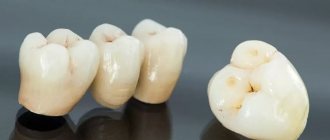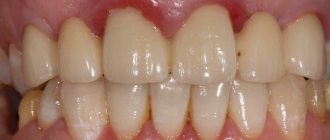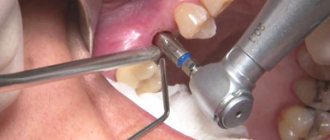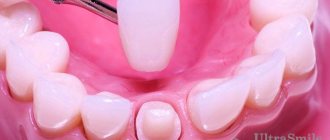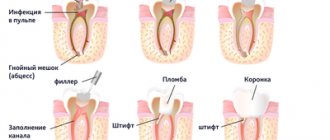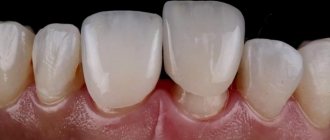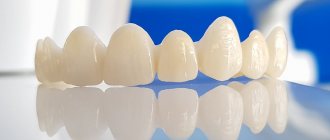The use of metal-ceramic crowns in the prosthetic procedure makes it possible to restore the natural anatomical configuration of a damaged tooth, its functionality, and also its aesthetic appearance. The price of metal-ceramic crowns is quite affordable and therefore this prosthetic option is incredibly popular among most patients in dental clinics.
In the article we will talk in detail about the process of installing metal-ceramic crowns on a tooth: we will consider the types of structures, indications and contraindications for their use, and also find out how much a metal-ceramic crown costs at Vanstom Dentistry in Moscow.
Metal-ceramic crown: design features
An orthopedic prosthesis made of metal-ceramics is a special onlay that is worn during the prosthetic procedure on a tooth that has previously been subjected to the grinding process. The shape of the metal-ceramic crown is identical to the anatomical configuration of natural teeth and repeats it down to the grooves on the tooth surface.
If you look at the photo of the metal-ceramic crown that we posted below, you will see that the base for creating the structure is a solid metal frame and the thickness of its walls can reach 0.5 millimeters. The contours of the frame are similar to the contours of the “native” tooth. On top, the frame base is covered with a layer of ceramics, which matches the color of the natural enamel coating.
Fixation of metal-ceramic crowns is carried out by fixing them on the prepared tooth using a special cementing composition.
Materials for the manufacture of metal-ceramic crowns
Metal alloys
To produce the frame of a metal-ceramic crown in modern dentistry, three types of alloys from different metals are used:
1. Alloys of cobalt and chromium, nickel and chromium. The cost of a metal-ceramic crown made from these alloys will be as low as possible, but it is worth knowing that the listed metals often cause allergic reactions and irritation of gum tissue, and therefore the savings obtained when installing them are questionable.
2. Alloys of palladium, platinum and gold. This material for the production of prosthetics has a number of advantages: hypoallergenic, the ability to create the most natural tone of the prosthetic structure, which is especially important in the process of restoring teeth included in the smile line.
Another type of alloy that is used in the production of metal-ceramic crowns is a mixture with titanium as a base. Titanium alloys are not capable of causing allergic reactions; when used, the risks of rejection and incompatibility of the prosthesis with the tissues of the oral cavity are minimal.
Metal-ceramic crowns
from 8000 rub. More about prices
We have been working since 1994
we are one of the first to open private dentistry in Moscow
Best materials
only new and modern equipment for dental treatment
Free
consultation with a dentist
Payment options
- cash
- plastic cards
- cashless payments
Doctors' experience
- with great experience
- graduated
- conference participants
Content:
In modern orthopedic dentistry, a metal-ceramic tooth crown is one of the most popular and versatile types of prosthetics. Inside is a durable metal base made of chrome, cobalt, nickel or gold. Outside – aesthetic ceramics.
In this article we will tell you in detail what are the features, pros and cons of metal-ceramic crowns? What is the cost of metal-ceramic crowns in Krasnodar? How does the installation work? What should be done to extend their service life?
Metal-ceramic crowns before and after photos of our patients
Photo before
Photo after
Ceramic coating
The metal frame of the orthopedic structure is covered with a layer of dental ceramics, which in composition is almost similar to household ceramics, however, the compositions for lining metal-ceramic crowns contain an increased content of components such as albite and orthoclase, which increase the strength of the created layer.
The ceramics are applied to the frame in layers and specialists use a special tool for this work. After applying the next layer, the structure is fired in a vacuum oven. This is necessary to ensure the strongest possible adhesion of the ceramic layer to the frame.
Reviews of metal-ceramic crowns from patients indicate that this type of dental orthopedic structures is not only strong and durable, but also highly aesthetic, which makes it possible to regain an attractive and natural smile!
Installation steps
Installing metal-ceramics is practically no different from fixing crowns made of other materials. The dental restoration algorithm includes the following stages:
| Preparation | • Comprehensive examination of the client, exclusion of contraindications, determination of the optimal prosthetic option • Treatment of the oral cavity: professional cleaning, treatment of inflammatory processes • Preparation of the tooth for a crown (turning) • Taking impressions of the dentofacial apparatus |
| Manufacturing | • Creation of a metal frame based on the casts obtained • Trying on the frame and correcting defects • Finishing with durable, color-matched ceramics |
| Installation | • Reliable fixation of the crown using one of the selected methods: with a pin, supported by an implant • Recent aesthetic measures: grinding, polishing if necessary |
To improve the aesthetics of the design, Smile dentists make crowns with shoulder mass. That is, the edges of the metal frame are lined with ceramic material. This allows you not only to improve the appearance of the artificial tooth, but also to avoid metal showing through in the area where the crown transitions to the natural tooth.
Indications and contraindications for the installation of metal-ceramic crowns
Installation of a metal-ceramic crown is indicated in the following circumstances:
1. If there is a need to reconstruct damaged teeth to restore full chewing function and aesthetic appearance.
2. Metal-ceramic crowns are indicated for installation in case of abnormal position of teeth in a row, to eliminate a number of aesthetic defects: discoloration of natural enamel, severe chips.
Like any other medical procedure, prosthetics with metal-ceramic structures also has a number of limitations:
1. Metal-ceramic crowns cannot be installed if you are allergic to metal alloys.
2. You should refrain from the procedure if you have weak and painful gums, periodontal diseases, or malocclusion.
Metal-ceramic crowns are not placed on young patients under 16 years of age.
Caring for metal-ceramic crowns
Along with the fact that caring for artificial metal-ceramic teeth is quite simple, there are some rules that, if followed, can extend the service life of the products:
- You need to brush your teeth at least twice a day. Movements should be vertical, directed towards the tooth edge from the gum;
- The brush should have soft bristles. Any paste can be used according to the patient’s individual preferences;
- You should not limit yourself to just brushing, since food remains remain in the interdental spaces. To remove them, you need to use dental floss;
- After brushing, you should rinse your mouth with clean water and only then use an antiseptic mouthwash;
- Lovers of coffee or other coloring foods and drinks, as well as smokers, are recommended to have their teeth professionally cleaned at least twice a year. Whitening pastes will not provide a positive effect in caring for metal ceramics, so home whitening is not advisable.
In addition to hygiene procedures, you also need to know that strong mechanical loads can lead to cracks and chips in the ceramic coating. Also, sudden temperature changes worsen the condition of the dentures, so it is not recommended to eat excessively hot or very cold food.
The process of installing metal-ceramic crowns
The main task of a specialist in prosthetics using metal-ceramic crowns is the accurate reconstruction of the root part of the tooth and its crown part. This is essential for completely restoring the functionality of the tooth.
In the restoration of the root part of the tooth, the following can be used:
- Stump inlays. Their use is advisable when the tooth root is healthy and does not have significant damage;
- Dental implant in cases of lost root part.
The prosthetics process takes place in two main stages, which are worth talking about in more detail.
How are crowns placed on one tooth?
A common installation option is to mount it on one tooth.
This solution is suitable if your own tooth is already heavily affected by caries or has many chips and cracks.
When choosing a specific design, the doctor takes into account the condition of the tooth and how damaged it is.
There are several main options:
- When the root or remains of more than half of the natural tooth are intact. In this case, it will be possible to do without special structures, only with a crown installed on top. Before installation, it is necessary to carry out filling, grind off the base and perform depulpation.
- The coronal part was completely destroyed. To decide on installation, you will need to check the current state of the root system. In this case, the crown is placed on a special pin. It is fixed in the root canal and cemented.
- The tooth is completely destroyed. In this case, a standard implant is used. A crown is placed on a previously prepared base, which takes root over several months. There are different implantation options, including one-stage implantation.
With one crown, you can not only restore chewing ability, but also completely restore the aesthetics of your smile.
Free consultation on the cost of treatment in our dentistry
Leave a request and the clinic administrator will contact you within 15 minutes!
Preparatory stage:
1. The patient comes for examination to a specialist. After assessing the condition of the tooth and a series of studies, the dentist makes a decision on the prosthetic technique.
2. If the root part of the tooth is alive, then it is possible to carry out a series of therapeutic manipulations, during which the specialist eliminates all inflammatory and destructive processes, if necessary, the dental canals are re-filled and a pin is applied.
If the tooth root is significantly weakened, then the pin cannot be used, and in this case, before installing a metal-ceramic crown, the specialist uses a stump spacer, designed to replace bone tissue that has undergone the process of destruction.
3. If the root of a tooth is missing or severely damaged, a dental implant must be installed. A metal-ceramic crown on an implant will cost more than other options, but this type of prosthesis has maximum durability and strength and is visually indistinguishable from natural teeth.
After all clinical training activities are completed, the second stage of prosthetics begins - laboratory.
Laboratory stage of installation of metal-ceramic crowns:
During the laboratory stage of prosthetics with metal-ceramic crowns, the structure itself is manufactured. The process consists of the following stages:
- Taking impressions of the patient’s teeth;
- Modeling of the structure frame;
- Trying on the finished prosthesis;
- Correction of possible defects.
The process ends with the installation and fixation of a metal-ceramic crown.
How to place crowns on all teeth
This method of prosthetics is also suitable if several teeth are missing at once. In this case, the dentist will install a bridge.
The main condition is the presence of healthy teeth on which the structure could be fixed.
If there are none or the roots are not in the best condition, the only way out of the situation will be to implant support pins.
The cost and duration of production will depend on the current condition of the patient. All work may take several months. In this case, a temporary structure is installed that can be changed after some time.
Prices for prosthetics with metal-ceramic crowns in Moscow
Moscow dentists offer different prices for metal-ceramic crowns. Prices for the service depend both on the clinic’s pricing policy and on a number of completely objective factors, including:
- Material for the manufacture of metal-ceramic crowns;
- The complexity of the clinical stage of preparation for prosthetics. Metal-ceramic crowns on an implant will be the most expensive option, since the process of installing them is a specific and complex task.
Do you want to restore lost teeth by installing metal-ceramic crowns? Contact our Vanstom dental clinic in Moscow: we guarantee high quality work in which we use modern materials and technologies, and will also pleasantly surprise you with affordable prices for metal-ceramic prosthetics.
Advantages of metal ceramics
Compared to many other types of crowns, metal-ceramic structures have a number of advantages:
- High strength, so they are placed on chewing teeth
- Good aesthetic characteristics
- Resistance to mechanical damage
- Ability to create a bridge
- Ceramics are not stained by food coloring
- Long service life
- Moderate cost compared to all-ceramics and zirconium structures
The Smile dental clinic uses only proven, reliable materials for the manufacture of crowns. The service life of such structures is, subject to proper care, at least 10 years.
Metal-ceramic crowns: price
| — Consultation with a dentist-orthopedist | 0 rub. |
| — Metal-ceramic crown | 8000 rub. |
| — Metal-ceramic crown with a ledge | 10,000 rub. |
| — Metal-ceramic crown on an implant | 12000 rub. |
| — Metal-ceramic crown on precious metals | from 14500 rub. |
| — Metal-ceramic crown with effect masses | 13000 rub. |
| — Metal-ceramic crown with cervical mass | 13700 rub. |
View price list
